by Winding Pathways | Oct 20, 2022 | (Sub)Urban Homesteading, Chickens, Garden/Yard
One of our 14 chickens is a true American Ninja Chicken. Most of us know the TV program American Ninja Warriors where athletes navigate extreme obstacles to beat the buzzer. Well, this gal, a California White, is right up there with the most athletic of them all.
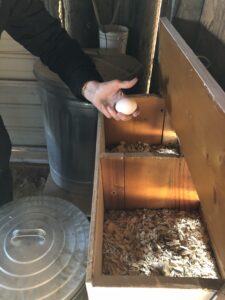
Our American Ninja Warrior Chicken begin to lay eggs at about 20 weeks.
Like most hens, when she reached about 20 weeks old, she laid her first egg in our coop. Then another a couple of days later. Then, none. And, none the next day. That’s unusual. When a hen starts laying, she’ll usually continue.
One evening, Rich counted the hens. There were 13. Hmmmm. Where’s the 14th? Had she met her fate? After recounting three times, checking the run, and scratching his head over this mystery, came a cluck from the attic of the barn. Could she have made the tortuous way up through the rafters into the barn’s attic? Naw. No chicken could do that. Then we remembered that another California White hen had laid eggs in the barn attic. So, Rich got the stepladder and checked anyway.
There she was up in the barn attic above the coop our second American Ninja Chicken proudly looking at her freshly laid egg.
Are Ninja Chickens Dumb Clucks? Not Really
A chicken myth is that they are dumb. Everyone “knows” that. Nope. Not true. To get into the attic our hen had to be both smart and athletic. Brains figured out a pathway through rafters, plywood, spools of wire, and stored items. Athleticism got her there. She negotiated an obstacle course like what we watch on TV’s American Ninja Warrior.
Once she reached the barn attic, she found the darkness and privacy hens appreciate when nesting. Unlike human ninjas,
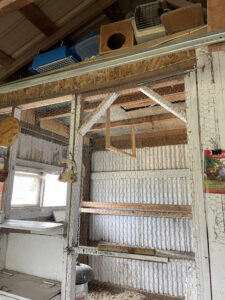
The American Ninja Warrior Chicken wormed her way to the barn attic.
there wasn’t a buzzer to ring when she got up there, but her clucks gave away her presence.
We admire her athleticism and smarts, but laying eggs up there won’t work. We need to easily collect them. So, we spent a morning plugging up any possible route to the attic.
We may have succeeded. Today’s egg was in the coop, but we’re certain she’s trying to figure out how to again reach the attic. She might outwit us.
When do Chickens Start Laying Eggs?
Female baby chicks usually start laying when they are 16 to 24 weeks old. Of the many breeds of chickens those that lay white eggs are relatively small, agile, and intelligent. They can worm their way into inaccessible places and fly like a pheasant. In contrast, most brown egg layers are heavy and cumbersome, and struggle just trying to get airborne.
Our American Ninja hen is a California White, a Leghorn hybrid. She’s small, fast, agile, and determined and lays white eggs – in the attic of the barn.
by Winding Pathways | Apr 28, 2022 | (Sub)Urban Homesteading, Chickens, Foraging, Garden/Yard, Garden/Yard, Weeds
We are shocked by the rise of many prices, especially food. Fortunately, we mute the cost by finding or growing groceries here at Winding Pathways. We’re lucky to own two acres, but folks living on tiny lots can produce an amazing amount of food, even if they aren’t passionate gardeners.
In a nutshell here’s what we do to tame grocery bills:
Foraging
It’s ironic that many people consider the most delicious and easy wild foods pests and spend time and money trying to eliminate them. We eat ‘em. Books and websites, including Winding Pathways, share tips on finding, identifying, harvesting, cooking, and eating wild foods. Caveat: ALWAYS check that you have the correct plant, gather from unpolluted places, and consume only a small amount initially to be sure your body accepts the wild edible.
Here are our favorites:
Gardening
We’re not passionate gardeners and we don’t can or freeze vegetables, so here’s what we do:
- Succession plant: Our small garden yields an enormous amount of food. We don’t let a square foot be idle. When summer’s heat turns lettuce bitter, we pull it, feed it to our chickens, and plant beans or another heat-loving crop. Same with other crops that grow quickly and then fade.
- Use vertical space: Pole beans, for example, produce much more food per square foot than bush beans, so we choose climbers and use vertical space. We have the pole high enough to reach up and pull off the beans.
- Grow dwarfs: Some cucumber varieties, for example, are “bush” type, meaning they produce a crop without long vines that consume plenty of space.
- Think of winter eating: Because we lack freezer space and don’t can food, we plant vegetables that need little care during the growing season and store them until late winter without being canned or frozen. Here’s our list:
-
- Winter squash. Pick them, let them curet, and store them in a cool spot. They keep for months. Same with pie pumpkins.
- Carrots and parsnips. In late fall we smother the plants with a thick blanket of dry leaves or straw that keeps the ground from freezing. We’ve harvested carrots in January by brushing away snow and peeling back the mulch and pulling them.
- Sweet potatoes. They love the South’s climate yet grow well up north.
We carefully dig them in the fall, cure them, and store them like winter squash.
-

-
Sweet potatoes are a healthy vegetable.
-
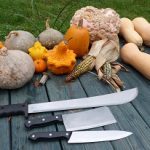
-
Winter Squash vary in color, texture, shape and size.
Chickens
We can’t imagine living without a small chicken flock. Our six to 12 hens gift us a couple of dozen eggs a week. Their manure fertilizes the garden and garden weeds are a great hen chow. During warm months our hens forage in their large run eating bugs, worms, and weeds and transforming them into eggs. Sometimes we even stew down an old hen.
-
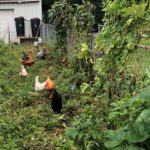
-
In the summer hens find plenty to eat.
-
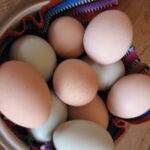
-
The chickens kept on laying eggs.
-
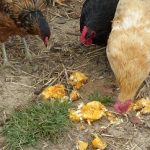
-
Chickens efficiently recycle squash seeds to eggs.
Wildlife
Lots of folks don’t like hunting. For us harvesting a deer is a form of food gathering, not recreation. After all, deer are free-ranging, local, and organic. Fortunately, we’re able to hunt on our property and convert a deer into delicious meat. We also enjoy eating panfish.
Like most folks, we can’t grow or forage all our food but much comes from the yard and area. It takes knowledge and investment in elbow grease but trims the food budget. Perhaps even better, knowing how to find and grow food makes us feel less vulnerable to national disruptions that make food either hard to get or expensive.
by Winding Pathways | Mar 31, 2022 | (Sub)Urban Homesteading, Chickens, Reflections/Profiles
Keep the Photos!
An old photo or letter can bring back memories. That happened to Rich recently and helped him recognize both good parenting and a lifelong passion.
Rich was sorting through a stack of family documents when he discovered a paper his mother wrote in his “baby” book. Written in 1959, when Rich was nine, it stated that he wanted to be a chicken farmer! Of all things for a kid growing up in suburban New Jersey to say.
Rich became fascinated with chickens while only four or five years old. By the time his mother wrote in the book he had learned many chicken breeds. Another letter, dated May 5, 1959, was written as an exercise in his elementary school. The teacher was teaching students letter writing. Rich’s note to his mother said:
Thank you for taking me to the chicken farm. Now I know what a black hen looks like. I now know why one costs more than a Leghorn. I’m going to cook breakfast for you. Happy Mother’s Day. Love, Rich
A Budding Entrepreneur
A third document is an account of how many eggs his hens laid each day and a bill presented to a customer. 65 cents for a dozen in 1960. Adjusted for inflation that dozen would cost $6.50 today.
-

-
Dreaming of the future
-
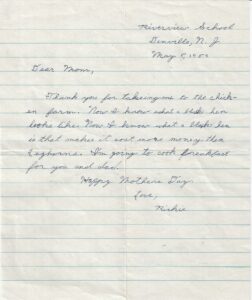
-
Expressing appreciation
-
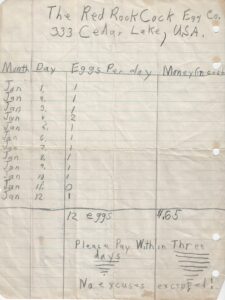
-
Learning math and writing.
A pair of photos show 13-year-old Rich at his junior high school science fairs. One science project was titled, The Effect of Vitamin E on the Hatchability of Chicken Eggs, and the other demonstrated an incubator.
-

-
A science project
-

-
Scientific studies.
What Do These Documents Signify?
- Great parenting. It must have seemed weird to his parents that their young child had such an unusual passion, but they helped, learned, and encouraged.
- Chickens helped teach math, animal care, writing, business, and research methods.
- Chickens became a lifelong passion.
Rich encourages parents to encourage their children’s passions. They might lead to lifelong hobbies and, perhaps, even a career.
Update on Careers
Rich never became a chicken farmer, per se, but he is co-owner of Winding Pathways where we encourage people to be creative in how they interact with nature and to consider backyard chicken raising. He developed another passion, fish, and earned a degree in fishery biology, and served as a biologist in Alaska.
by Marion Patterson | Sep 4, 2020 | Chickens
Well, you don’t. These powerful storms develop quickly from what seems like a “normal” thunderstorm. Even the weather service can be caught off guard as happened Monday, August 10, 2020, as a series of storms developed over Nebraska and swept East rapidly.
Gustavus Hinrichs, a Danish immigrant, and professor at the University of Iowa, recognized these storms differ from hurricanes because the winds move quickly in a straight line. Hence, derecho.
This link has satellite imagery of the formation of the derecho with Eastern Iowa being the epicenter. Over 20 counties have qualified for disaster aid.
Winding Pathways sustained damage especially the trees. And, we are working each day in the community to help recover. In the future, create.
For now, we invite readers to support local organizations in communities damaged by natural forces like fires, storms, and droughts.
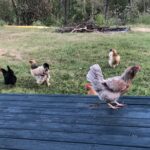 We are OK. The chickens were truly “free-ranging” for ten days before we got temporary fencing back up. They keep eating our food scraps, foraging for insects, and laying eggs so all is well.
We are OK. The chickens were truly “free-ranging” for ten days before we got temporary fencing back up. They keep eating our food scraps, foraging for insects, and laying eggs so all is well.
And, we will update as we can.
Go to our posts on preparedness and we will post updates of what we learned to add to preparedness. Remembering that different emergencies require different responses and different preparedness techniques.
Be well.
by Winding Pathways | Sep 18, 2018 | (Sub)Urban Homesteading, Chickens, Garden/Yard
Hoover’s Hatchery is sponsoring a “Chicken Shaming” contest! Seriously! Join the fun for some good clean Chicken Shaming by sending your story and photo. Winding Pathways works closely with Hoover’s Hatchery and we love their work.
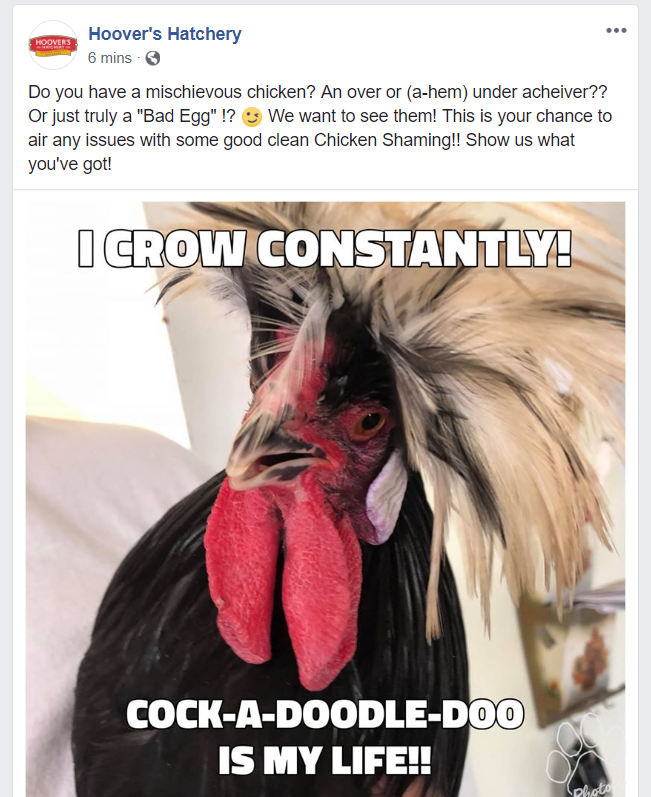
Hoovers Hatchery Invitation




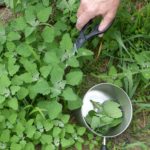












 We are OK. The chickens were truly “free-ranging” for ten days before we got temporary fencing back up. They keep eating our food scraps, foraging for insects, and laying eggs so all is well.
We are OK. The chickens were truly “free-ranging” for ten days before we got temporary fencing back up. They keep eating our food scraps, foraging for insects, and laying eggs so all is well.